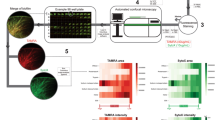Abstract
Studying biofilm formation and influence of the matrix composition was heavy because only old and long methods were employed up to now: confocal microscopy, fluorescent chemical markers, and/or dying techniques. In this context, an innovative tool, the BioFilm Ring Test®, was here employed to explore the role of exopolysaccharides, proteins, and nucleic acids in the formation of biofilm by Leuconostoc mesenteroides. The principle is to add magnetic particles in the culture medium. When a biofilm is formed, particles are unable to migrate in the media to form a ring when a magnet is brought nearer to the well. Therefore, culture media supplemented with proteases, glycanases, and/or nucleases allowed us to identify the involvement of these substances in L. mesenteroides biofilm formation. The results permitted to demonstrate that dextran, proteins, and nucleic acids are implied in biofilm formation.





Similar content being viewed by others
References
Sutherland, I. W. (2001). Trends in Microbiology, 9(5), 222–227.
Wozniak, D. J., Wyckoff, T. J., Starkey, M., Keyser, R., Azadi, P., O’Toole, G. A., et al. (2003). Proceedings of the National Academy of Sciences of the United States of America, 100, 7907–7912.
Zhang, X., Bishop, P. L., & Kupferle, M. J. (1998). Water Science Technology, 37, 345–348.
Latasa, C., Solano, C., Penades, J. R., & Lasa, I. (2006). Compte Rendus Biologies, 329, 849–857.
Branda, S. S., Vik, A., Friedman, L., & Kolter, R. (2005). Trends in Microbiology, 13(1), 20–26.
Padmanabhan, P. A., & Kim, D. S. (2002). Carbohydrate Research, 337, 1529–1533.
Chavant, P., Gaillard-Martinie, B., Talon, R., Hébraud, M., & Bernardi, T. (2007). Journal of Microbiological Methods, 68(3), 605–612.
Pentillä, M., Nevalainen, H., Rätto, M., Salminen, E., & Knowles, J. (1987). Gene, 61, 155–164.
Bradford, H. M. (1976). Analytical Biochemistry, 72, 248–254.
Waffenschmitd, S., & Jaenicke, L. (1987). Analytical Biochemistry, 165, 337–340.
Santos, M., Teixeira, J., & Rodrigues, A. (2000). Biochemical Engineering Journal, 4(3), 177–188.
Shamala, T. R., & Prasad, M. S. (1995). Process Biochemistry, 30(3), 237–241.
Vandamme, E. J., De Baets, S., & Steinbüchel, A. (2001). Biopolymers: Polysaccharides from prokaryotes (vol. 5, pp. 300–312). Weinheim: Wiley VCH.
Spoering, A., & Lewis, K. (2001). Journal of Bacteriology, 183(23), 6746–6751.
Poulsen, L. (1999). Lebensmittel Wissenshaft und Technology, 32, 321–326.
Author information
Authors and Affiliations
Corresponding author
Rights and permissions
About this article
Cite this article
Badel, S., Laroche, C., Gardarin, C. et al. New Method Showing the Influence of Matrix Components in Leuconostoc mesenteroides Biofilm Formation. Appl Biochem Biotechnol 151, 364–370 (2008). https://doi.org/10.1007/s12010-008-8199-y
Received:
Accepted:
Published:
Issue Date:
DOI: https://doi.org/10.1007/s12010-008-8199-y




